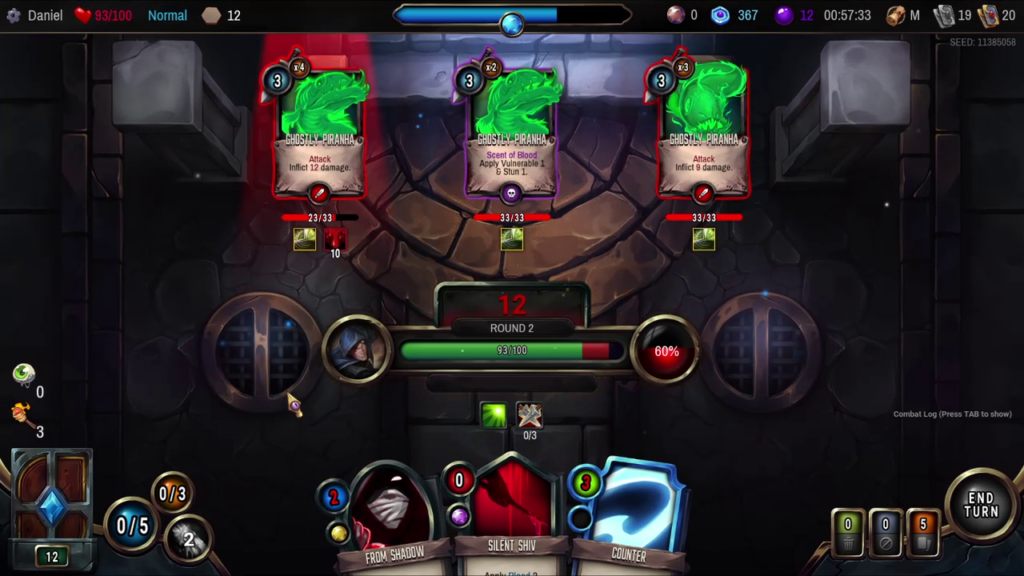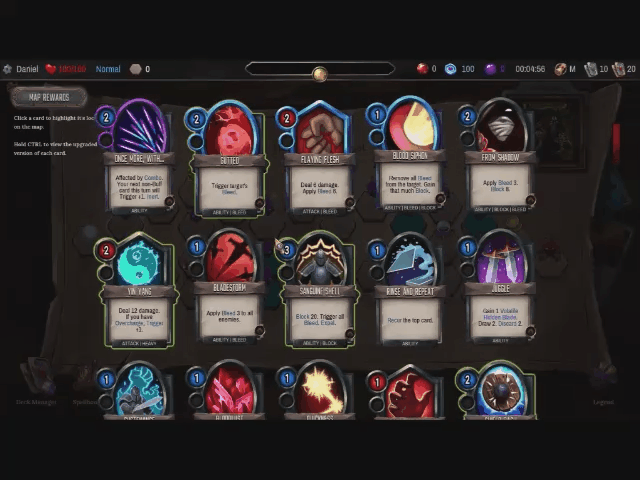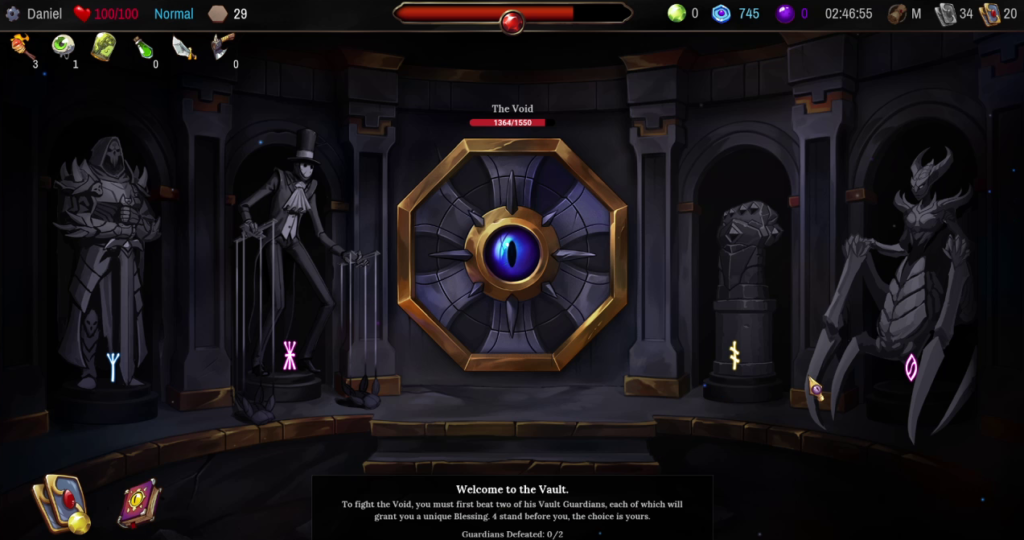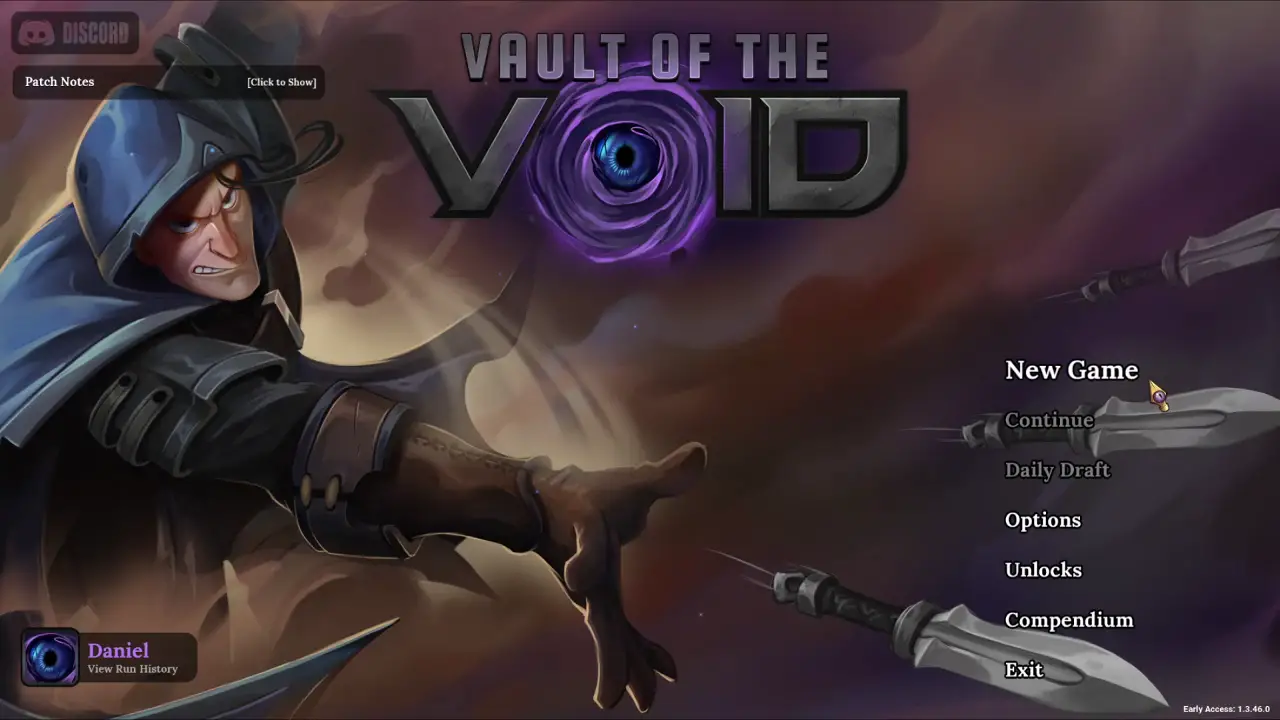FOUNDATIONS
While Megacrit wasn’t, strictly speaking, the first developer to combine deckbuilding with roguelike dungeon crawling (check out 2014’s Dream Quest for a primordial example), their contemporary classic Slay the Spire will probably still be remembered as the original. Thus, we observe the plight of the modern fantasy roguelike deckbuilder. When you look at Vault of The Void, the comparisons are inescapable, not helped by the similarly alliterative title, but heed my warning: Don’t judge this book by its extremely derivative cover.
According to the International Playing Card Society, there are between 1,000 and 10,000 games you can play with a standard deck of playing cards depending on what you define as a different game, as even the slightest differences in mechanics and rules can totally change the attitudes and strategies that the game is approached with. For an easy example, consider how the popular playground game Tag could continue until the children who play it have grown old and died without ever declaring a winner while, with a simple modification, its variant Freeze Tag is a finite game that a skilled player might win in a matter of minutes, if not seconds.

The graphic design in Vault of The Void is far from bad but does itself no favors so far by avoiding developing a distinct visual identity. Fortunately, it has been made abundantly clear a number of times that it is a work in progress and its visuals will be improved as it chugs on. That said, for the time being, it basically looks like Spire got a reskin to look like Hearthstone if Hearthstone had a slightly less legible font. Now that that’s out of the way, I have to admit that this is without question my favorite roguelike deckbuilder.
INNOVATIONS
Yes, it takes the basic formula from Spire, but this is no case of simple copyright dodging. It refines its mechanics enough to provide a far more luxuriant pure play experience. If Slay the Spire is good ol’ American Football, then Vault of The Void is Rugby, a game that foregoes excesses like padding and breathing room in favor of a faster, more player-centric game. Football is arguably a lot more nuanced in practice thanks to its constant intermissions, in service of achieving downs and providing more opportunities for the coaches to provide tactical interventions. In Spire, you’ll constantly butt up against the fact that you sometimes are given cards whose energy costs exceed your allowance. Therefore, you have to begrudgingly surrender them to the gluttonous discard pile before the enemy will take their turn. If staring at the screen and being frustrated at things you can’t control is your idea of a good time, that’s the one you want.
It’s not like that in Vault, thanks to the Purge system. Unless you’d care to save your cards for your next turn, you can discard the chaff from your hand in exchange for an additional point of energy that can be used to power your other cards and, in some cases, trigger additional effects. Combined with the fact that you can actually anticipate which cards you’ll pick up from every tile on the map, it allows you to actively engage with the deckbuilding rather than making the best of whatever you happen to chance across, allowing you to curate your decks as you progress. You can use any combination of your cards as long as they total to twenty, which technically brings it slightly closer in line with a collectible trading card game than a pure deckbuilder.

Smartly, it also cribs the character abilities from Blizzard’s Hearthstone in the form of Spells that can be activated at no cost with the conceit that you have to go through a cooldown period before they can be played again, providing a lovely little safety net to anchor you amidst the shuffling chaos. What’s more, to add a nice little wrinkle on top of that, each of the three playable characters has multiple options for their signature spells along with unique cards and persistent mechanics.

While the deckbuilding is very entertaining, the meta-gaming progression is also pretty compelling. With little fanfare, you’ll steadily amass a collection of void stones through each run that you can attach to cards in order to enhance their functionality. The grey stones allow you to summon a copy of your card back into your hand once it’s been played so that you can make the most of openings and respond to developing threats while yellow cards tack on additional shielding. The steady trickling influx of void stones from your backpack and into your deck incentivizes a weighted appraisal of the strategy presently in play and incentivizes committing to a certain build without preventing you from adapting to emerging challenges.

Unfortunately, all good things must end. In this case, a run concludes when you’ve met one of two conditions. Either when you’ve paved through the floors and made it to the eponymous Vault of The Void, where you defeat its minibosses, taken their buffs, and slain the Void, or when you’ve perished in combat. Then, once you’re wrapped up, you’re gifted a number of Vault Points which allow you to cash out for a number of aesthetic customizations, limited to environments and card backs for now, or alternatively, you can exchange them for Challenge Coins! These allow you to add specific parameters to your runs that make for more unique play experiences, such as preventing you from accessing common cards and limiting your opportunities to heal, while wielding distinct artifact combinations.
THE EXPERIENCE
While it’s a little overwhelming at first, the UI presents everything you need to know very concisely. It’s always clear what each enemy is doing thanks to the forecast beneath their cards while the total sum of the damage being levied at you is always present in the very center of the screen and it’s plain to see exactly how many of each enemy type needs to be defeated to draw the battle to a close.
As with other card-based games, it’s frustrating when you get stuck with the wrong card on account of a simple mechanical, user error because there isn’t an undo button to remedy this. With the only save option being to save upon exit, save-scumming isn’t a readily available option. Given that it’s a single-player game without competitive components outside of a scoreboard, I personally find it stifling and, honestly, slightly disheartening every time it happens. It’s really more damaging to my patience than it ever could be to my avatar.
Much like Slay the Spire, I feel strongly that this game would benefit if it had some sort of cooperative or competitive setting. Given that it’s still in development, it isn’t particularly far-fetched to think that it very well may get one eventually. When it does, if it does, or when it launches, whichever comes first, you had better believe that I’m going to peer pressure my friends into snatching it up. They too must experience the roguelike horrors that lurk within The Vault of The Void!







